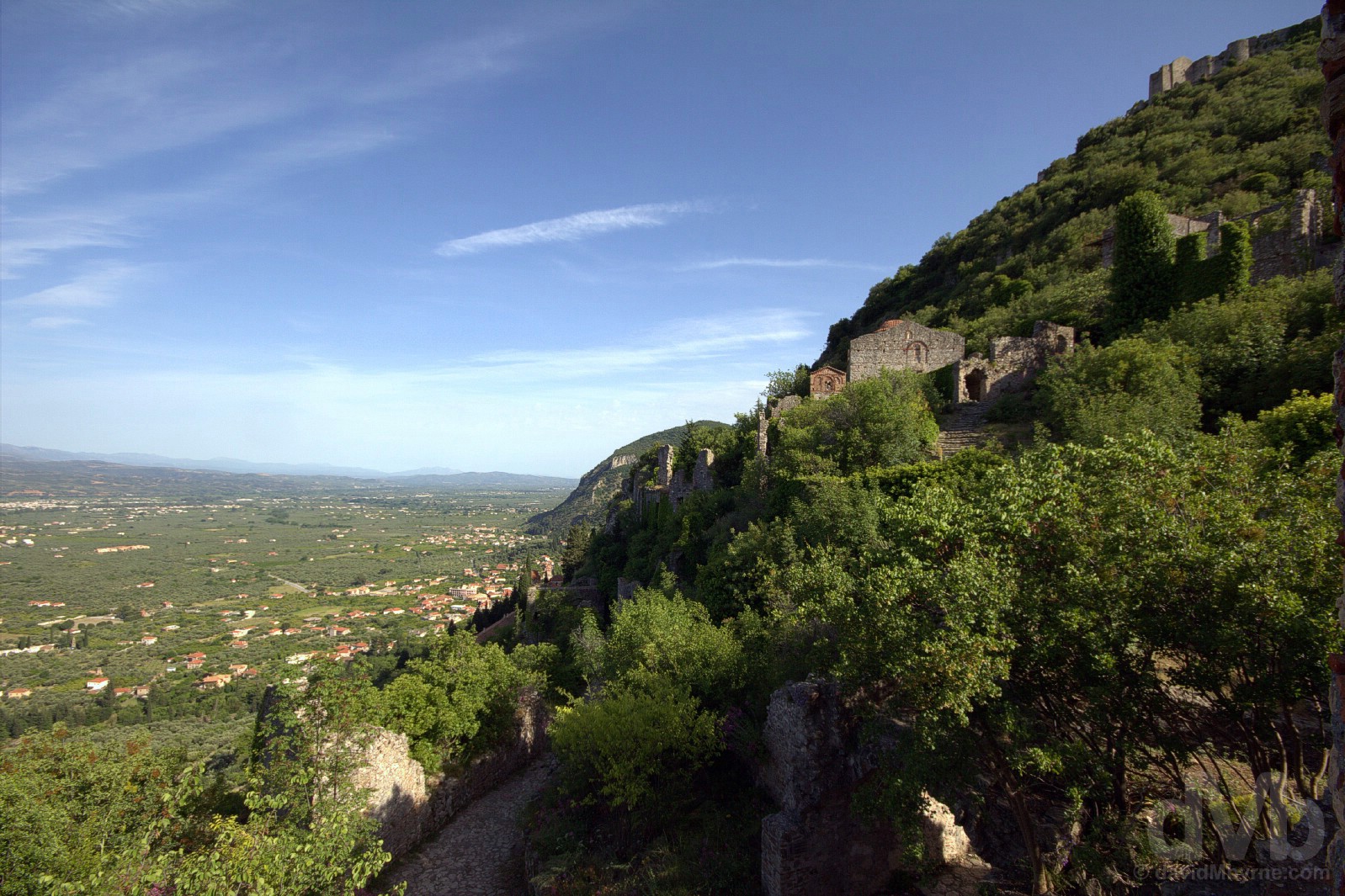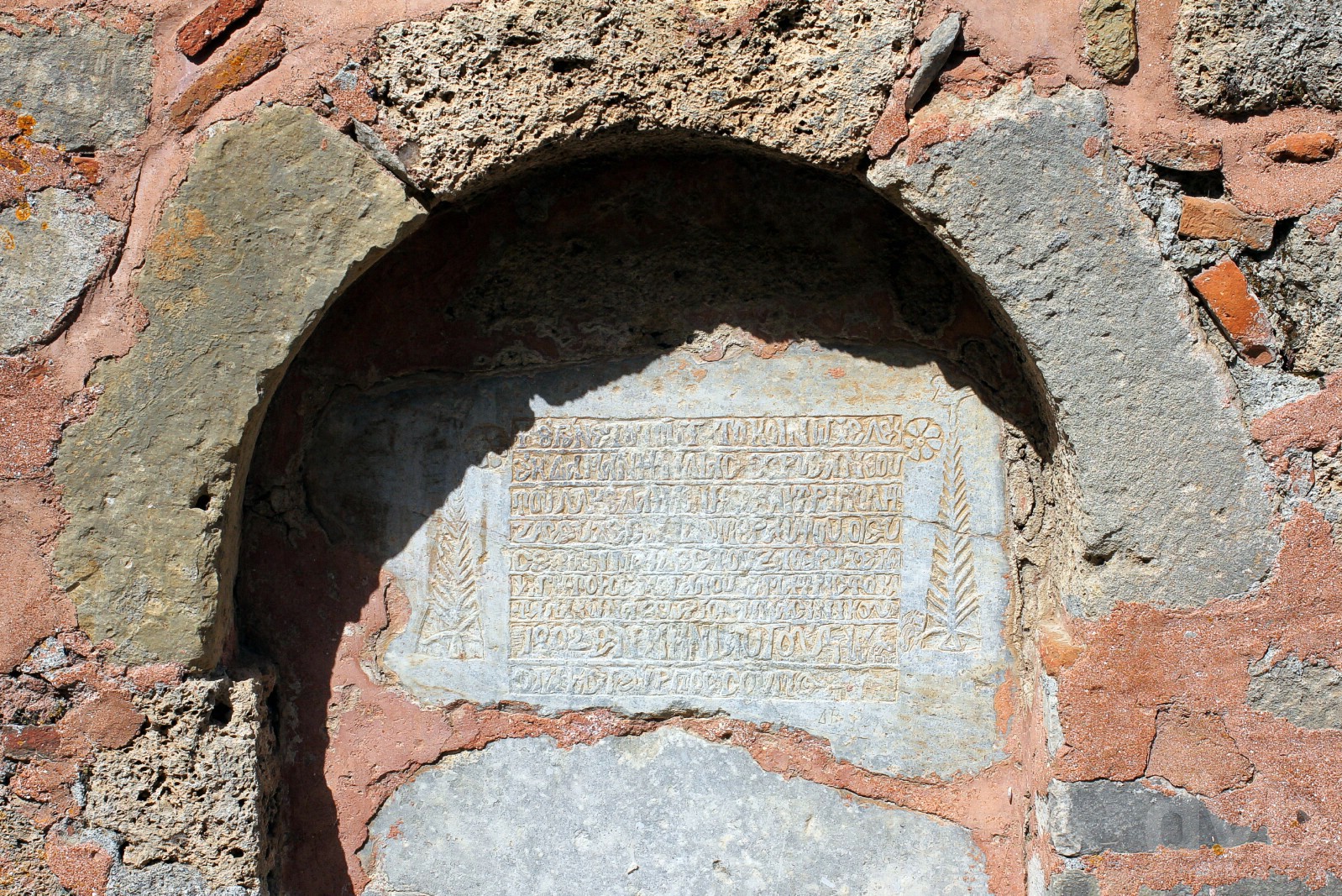Mystras, Greece
”In a country where antiquity is king, the fascinating tumbledown complex of churches and monasteries of the fortified UNESCO-listed mountain retreat of Mystras, last foothold anywhere for the once-mighty Byzantium Empire, feels like something of an upstart; it is only, at most, 800 years old.”
Image || The Church of the Virgin Hodegetria, Mystras, Peloponnese, Greece. May 8, 2017.
Mystras, Peloponnese, Greece
In a country where antiquity is king, the fascinating tumbledown complex of churches and monasteries of the fortified UNESCO-listed mountain retreat of Mystras, last foothold anywhere for the once-mighty Byzantium Empire, feels like something of an upstart; it is only, at most, 800 years old.

800-year-old ruins in a portion of the Lower City of the UNESCO-listed complex of Mystras on the slopes of Taygetus Mountain, Peloponnese, Greece. May 8, 2017.
dMb Country Overview - Greece
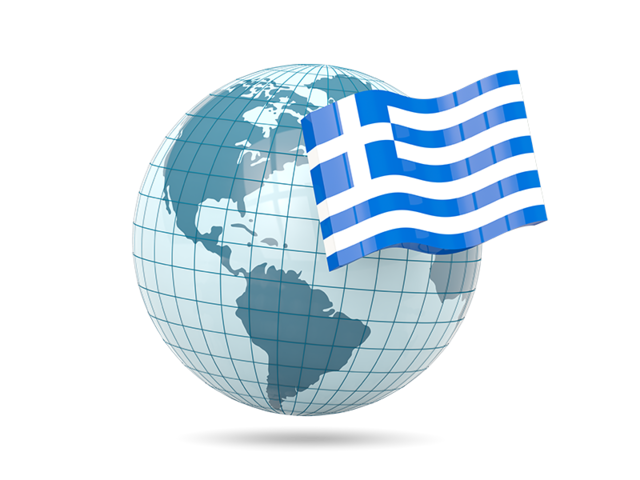 Greece
Greece
Region – Southeastern Europe/The Balkans (dMb tag: The Balkans). Capital – Athens. Population – 10.8 million. Official Language – Greek. Currency – Euro (€) GDP (nominal) per capita – US$21,000 Political System – Unitary parliamentary republic. EU Member? – Yes (10th member joined January 1981). UN Member? – Yes (founding member joined October 1945). G20 Member? – No. Size – 132,000 km² (Europe’s 15th largest country is approximately half the size of Ecuador, twice the size of Sri Lanka, and roughly the same size as the US southern states of Alabama and Louisiana. Topography – A mountainous interior (80% of Greece is mountainous), a long and convoluted coastline, and hundreds of offshore islands. Independence – 1830 from the Ottoman Empire following 1821 to 1830 Greek War of Independence. Brief History – From the eighth century BC, the Greeks were organised into various independent city-states, known as poleis (singular polis), which spanned the entire Mediterranean region and the Black Sea. Philip of Macedon united most of the Greek mainland in the fourth century BC, with his son Alexander the Great rapidly conquering much of the ancient world, from the eastern Mediterranean to India. Greece was annexed by Rome in the second century BC, becoming an integral part of the Roman Empire and its successor, the Byzantine Empire, which adopted the Greek language and culture. The Greek Orthodox Church, which emerged in the first century AD, helped shape modern Greek identity and transmitted Greek traditions to the wider Orthodox World. After falling under Ottoman dominion in the mid-15th century, Greece emerged as a modern nation state in 1830 following a war of independence. UNESCO World Heritage sites – 18. Tourism Catchphrase/Slogan – All Time Classic. Famous For – Endless coastline and beaches; shipping; democracy (born here); a classical and hallowed past; ouzo; sun-drenched islands; Alexander the Great; the Olympics; being the cradle of Western civilisation; food (tzatziki, feta, souvlaki, moussakas, yogurt, grapes, olives and olive oil); economic collapse & austerity.

Ouzo for sale in the village of Oia, Santoríni, Cyclades, Greece.

Ouzo for sale in the village of Oia, Santoríni, Cyclades, Greece.
Highlights – Cyclades island-hopping and the remnants of all that ancient history (Greece boasts four millennia of sun-bleached ruins, artefacts, and architecture). Greece Titbits – At nearly 14,000 km (8,500 miles), Greece has the 11th longest coastline in the world; Greece is considered the cradle of Western civilisation, being the birthplace of democracy, Western philosophy, Western literature, historiography, political science, major scientific and mathematical principles, Western drama, and the Olympic Games (the country’s rich historical legacy is reflected in part by its 18 UNESCO World Heritage Sites, as of 2017); the Greek economy is the largest in the region with an economy larger than all other Balkan countries combined, this despite its well-documented economic battering and subsequent austerity measures.
Visits – 2 (May 2008 and April/May 2017). Where I Went/What I Saw – Thessaloniki; The Cyclades (Santoríni, Paros, Mykonos, Delos, Tinos); Zakynthos/Zante; Olympia; Sparta; Mystras; Athens.
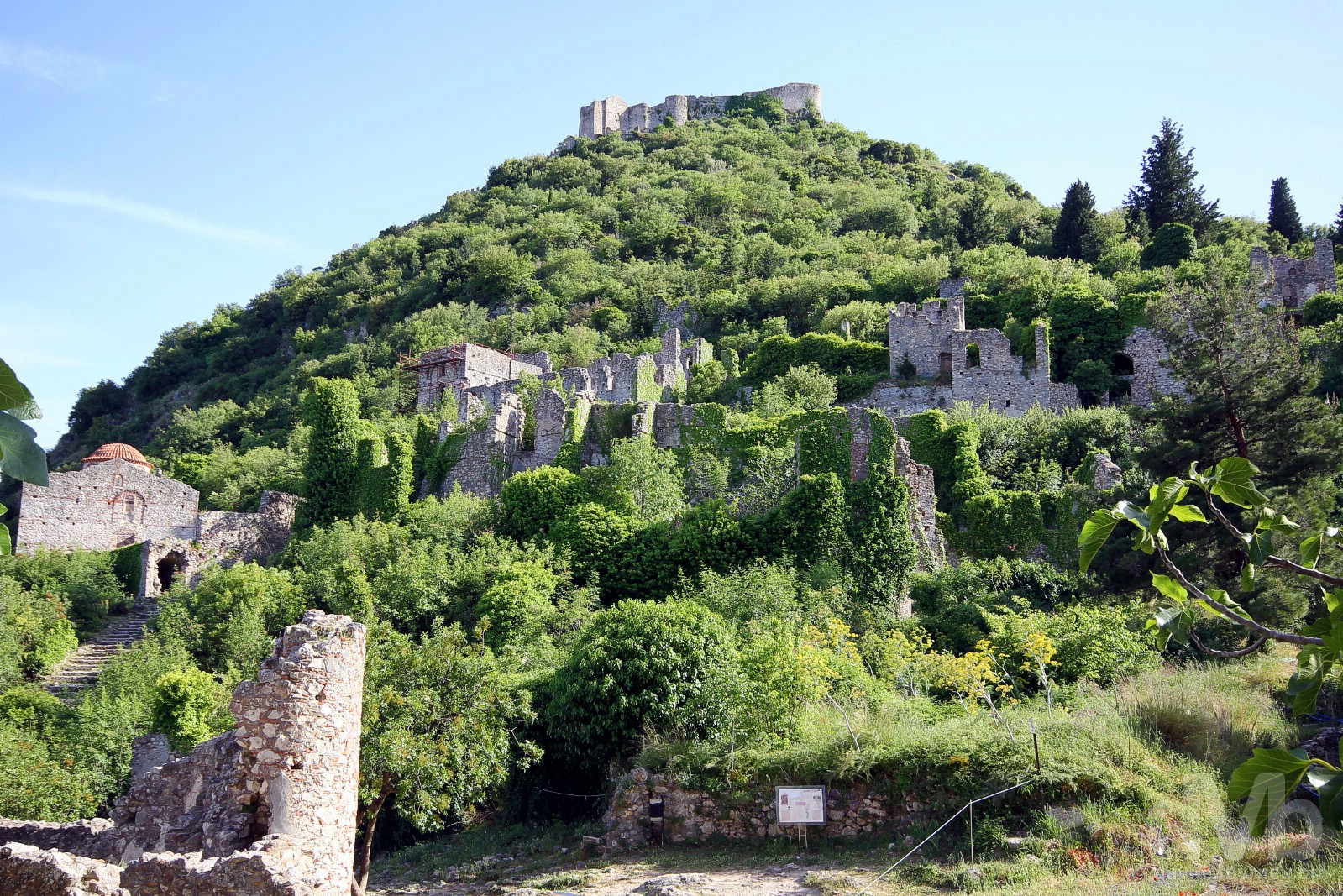
FORTIFIED MYSTRAS |The ruins of Mystras as seen from the Lower City looking beyond the Upper City towards the Frankish Citadel, aka Villehardouin’s Castle, atop the Hill of Mystras, a steep spur of the Taygetus Mountain overlooking the Evrotas River Valley and which afforded natural protection. Peloponnese, Greece. May 8, 2017.
As a typical late Byzantine fortified city, Mystras was built downward in three layers from the Citidel, the uppermost portion of the three-sectioned plan and a natural stronghold protected not only by its lofty perch but also by two successive lines of walled defence lower down, the Upper City and Lower City within which the settlement itself was built and its important residents lived (the peasant population lived outside of the protection of the city walls and sought refuge inside the fortified city in times of danger). While the remains of Mystras may not be very old, relatively speaking of course, ambling between and through the ruins and surviving structures – monumental gates, medieval houses, palaces, monasteries and faded fresco-studded churches – of a well-preserved Byzantine town that once sheltered a population of some 20,000 and that is scattered across a steep 620-metre-high lushly vegetated spur of Taygetos Mountain – the so-called Hill of Mystras – makes this UNESCO-listed site easily one of Greece’s most compelling historical sites.
The settlement of Mystras developed downward from a Frankish fortress built in 1249 at the top of a 620-metre-high spur of Taygetos Mountain overlooking the Evrotas River Valley and the town of Sparta.
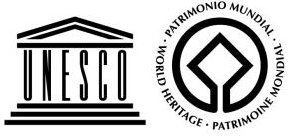 It fell into Byzantine hands in 1262 and was the residence of the Despotate of the Morea (or Despotate of Mystras), a province of the Byzantine Empire and its very last foothold, between 1348 until its surrender to the Ottoman Turks in May 1460, seven years after the fall of Constantinople. This century-plus of rule was a golden period of artistic renaissance with Mystras, the principal cultural and intellectual centre of the Byzantine world, attracting the best artists and architects of the day – indeed, it is said that the scholars based in Mystras at its artistic height influenced the 14th to 17th century Italian Renaissance. Aside from a brief occupation by the Venetians (from 1687 to 1715), Mystras stayed in Turkish hands and remained inhabited for the duration of Ottoman rule, and up until the formation of modern Greece as a result of the 1821-1830 Greek War of Independence. The site was finally abandoned for nearby modern Sparta in the 1830s, although the very last inhabitants were not relocated until 1953 as a result of restoration work that had begun shortly after the 1922 declaration of Mystras as an archaeological site (the Greek Civil War of 1946-1949 cut initial restoration efforts short). The site’s overall design and preservation, specifically with regard to the architecture of its Frankish castle, it palace, houses and fresco-infused churches, make Mystras an invaluable source for the study of the medieval culture of Byzantium, and Europe in general. For this, the site was awarded UNESCO World Heritage status in 1989.
It fell into Byzantine hands in 1262 and was the residence of the Despotate of the Morea (or Despotate of Mystras), a province of the Byzantine Empire and its very last foothold, between 1348 until its surrender to the Ottoman Turks in May 1460, seven years after the fall of Constantinople. This century-plus of rule was a golden period of artistic renaissance with Mystras, the principal cultural and intellectual centre of the Byzantine world, attracting the best artists and architects of the day – indeed, it is said that the scholars based in Mystras at its artistic height influenced the 14th to 17th century Italian Renaissance. Aside from a brief occupation by the Venetians (from 1687 to 1715), Mystras stayed in Turkish hands and remained inhabited for the duration of Ottoman rule, and up until the formation of modern Greece as a result of the 1821-1830 Greek War of Independence. The site was finally abandoned for nearby modern Sparta in the 1830s, although the very last inhabitants were not relocated until 1953 as a result of restoration work that had begun shortly after the 1922 declaration of Mystras as an archaeological site (the Greek Civil War of 1946-1949 cut initial restoration efforts short). The site’s overall design and preservation, specifically with regard to the architecture of its Frankish castle, it palace, houses and fresco-infused churches, make Mystras an invaluable source for the study of the medieval culture of Byzantium, and Europe in general. For this, the site was awarded UNESCO World Heritage status in 1989.
– UNESCO commenting on the Archaeological Site of Mystras
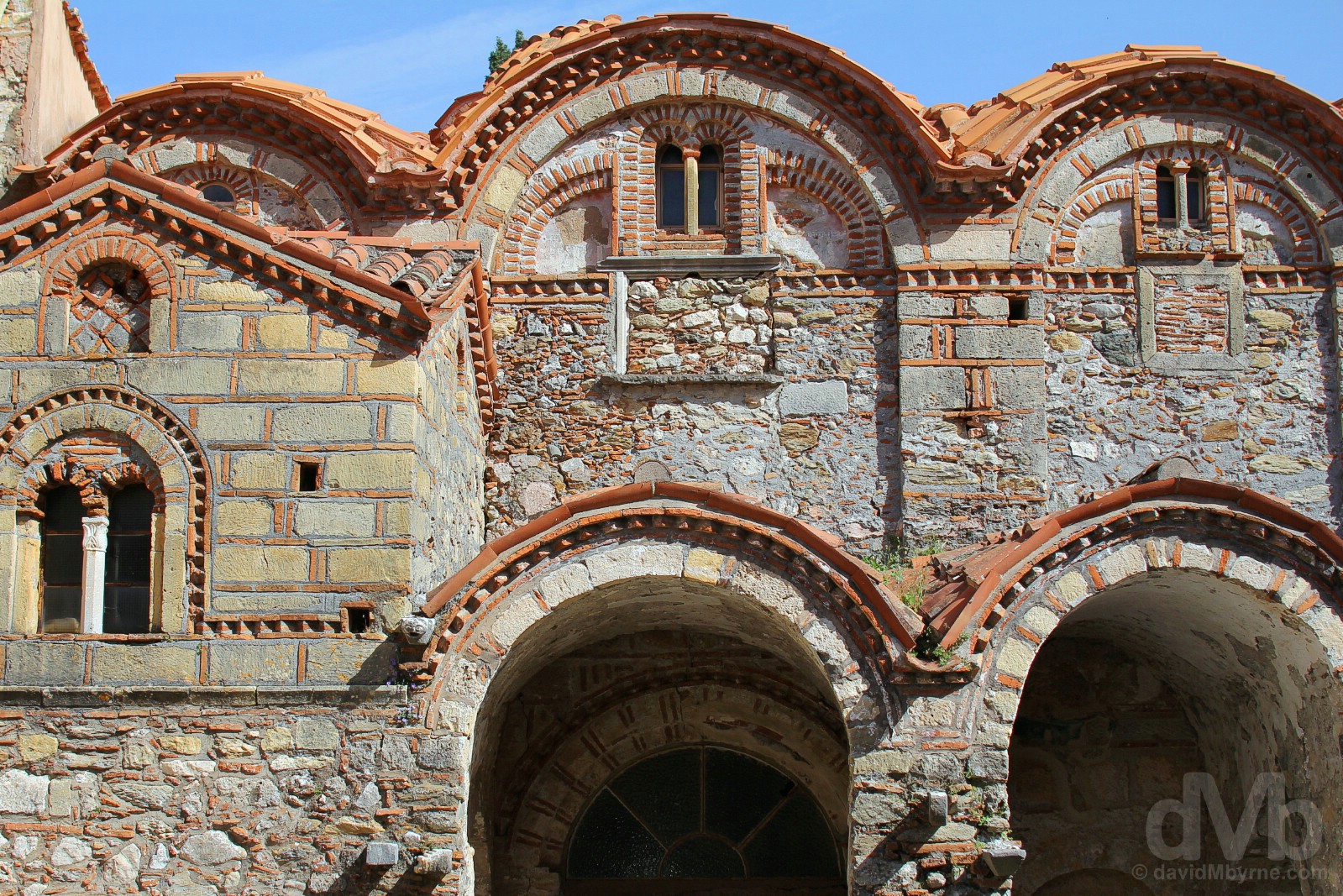
BYZANTINE ARCHITECTURAL RENAISSANCE | Church of Hagios Demetrios of the UNESCO-listed ruins of Mystras, Peloponnese, Greece. May 8, 2017.
As the principal cultural and intellectual centre of the Byzantine world from the mid-14th and early 15th centuries, Mystras was home to the final flourish of Byzantine architecture. Much of it remains today, the Church of Hagios Demetrios just one of the site’s many multi-domed and brilliantly frescoed churches, and the oldest – it dates to 1262.
– www.thebyzantinelegacy.com
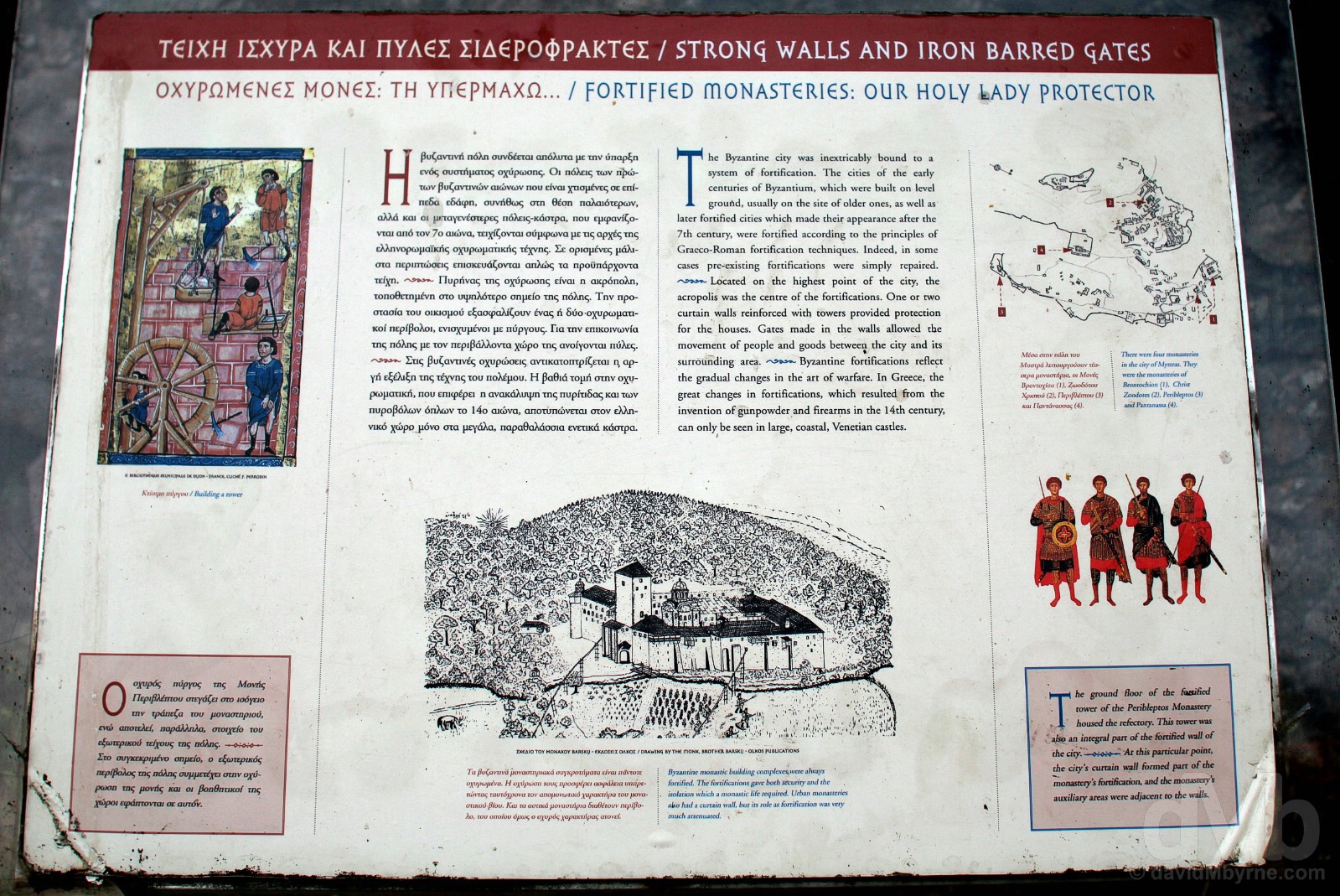
MYSTRAS LOOP | Information panels on display at the UNESCO-listed ruins of Mystras, Peloponnese, Greece. May 8, 2017.
Exploration of Mystras is normally done in a loop, the Mystras Loop; the site is laid out such that it’s up one side to the Citadel, and down the other. There’s a lot to see and even more to read – the information panels posted throughout the site, not just fronting the structures themselves, provide great insights into the design of and life in medieval Byzantine cities such as Mystras.
It doesn’t take long to do a loop of the Mystras site; it can be done in an afternoon at a leisurely pace, or a full day at a crawl. Either way, most start at the Main Gate in the Lower City and amble up through the Upper City to reach the crowning glory of the Citadel/Castle for sweeping views down over the site (and the Evrotas River Valley). The first port of call on most explorations of Mystras is the Metropolis of Mystras, Church of Hagios Demetrios, the the earliest of the surviving churches of Mystras.
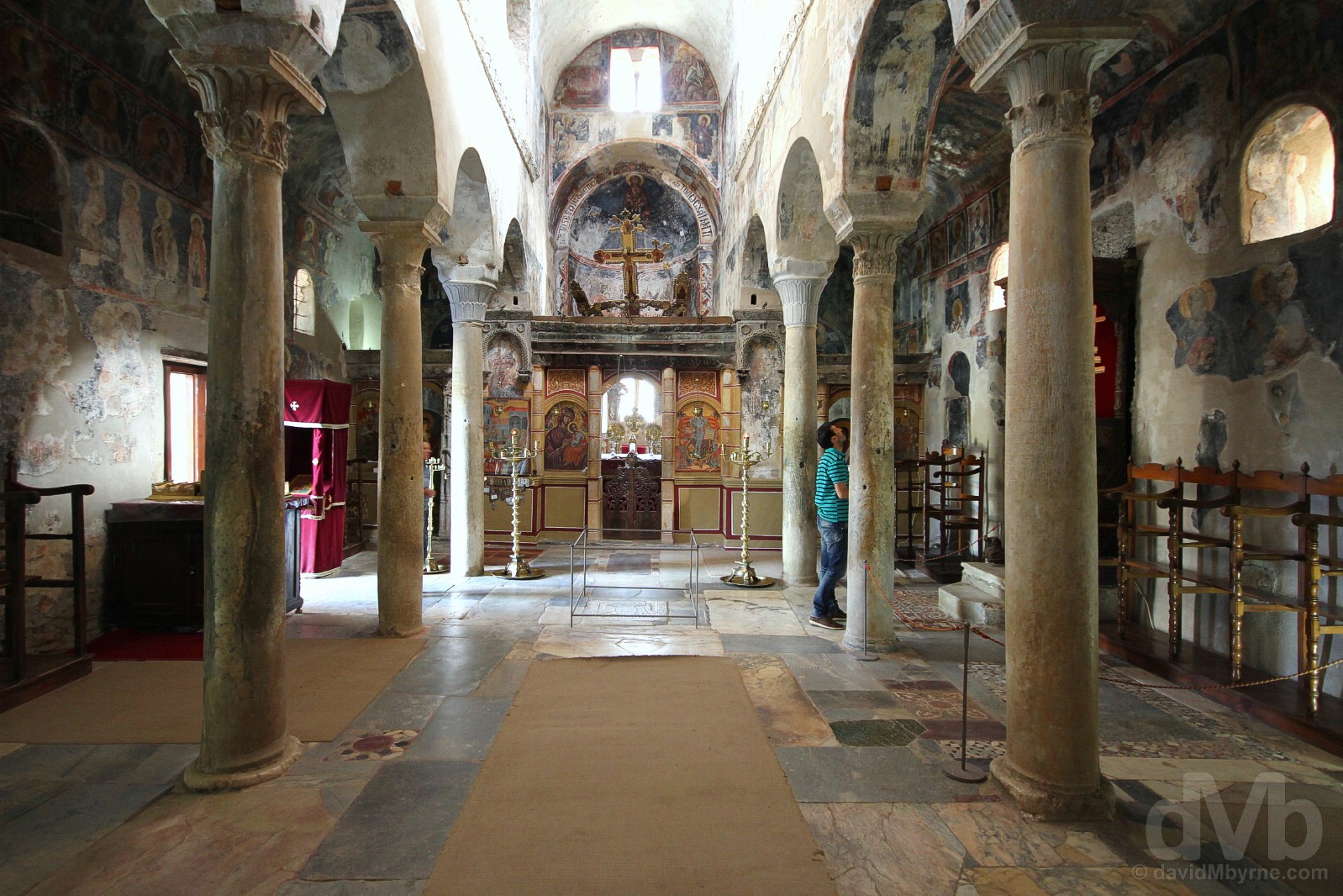
METROPOLIS/SAINT DEMETROIS | The interior of the 13th-century Metropolis/Church of Saint Demetrios, Mystras, Peloponnese, Greece. May 8, 2017.
The oldest of all Mystras churches, the Metropolis, or cathedral, built shortly after 1262 and dedicated to Saint Demetrios, is the centrepiece of a complex of ancillary religious buildings originally built beside the main thoroughfare of the Lower City. Originally a three-naved wooden-roofed basilica, its superstructure was subsequently converted, in the first half of the 15th century, to cruciform with a cupola, a mixed architectural style that came to be known as Mystras style.
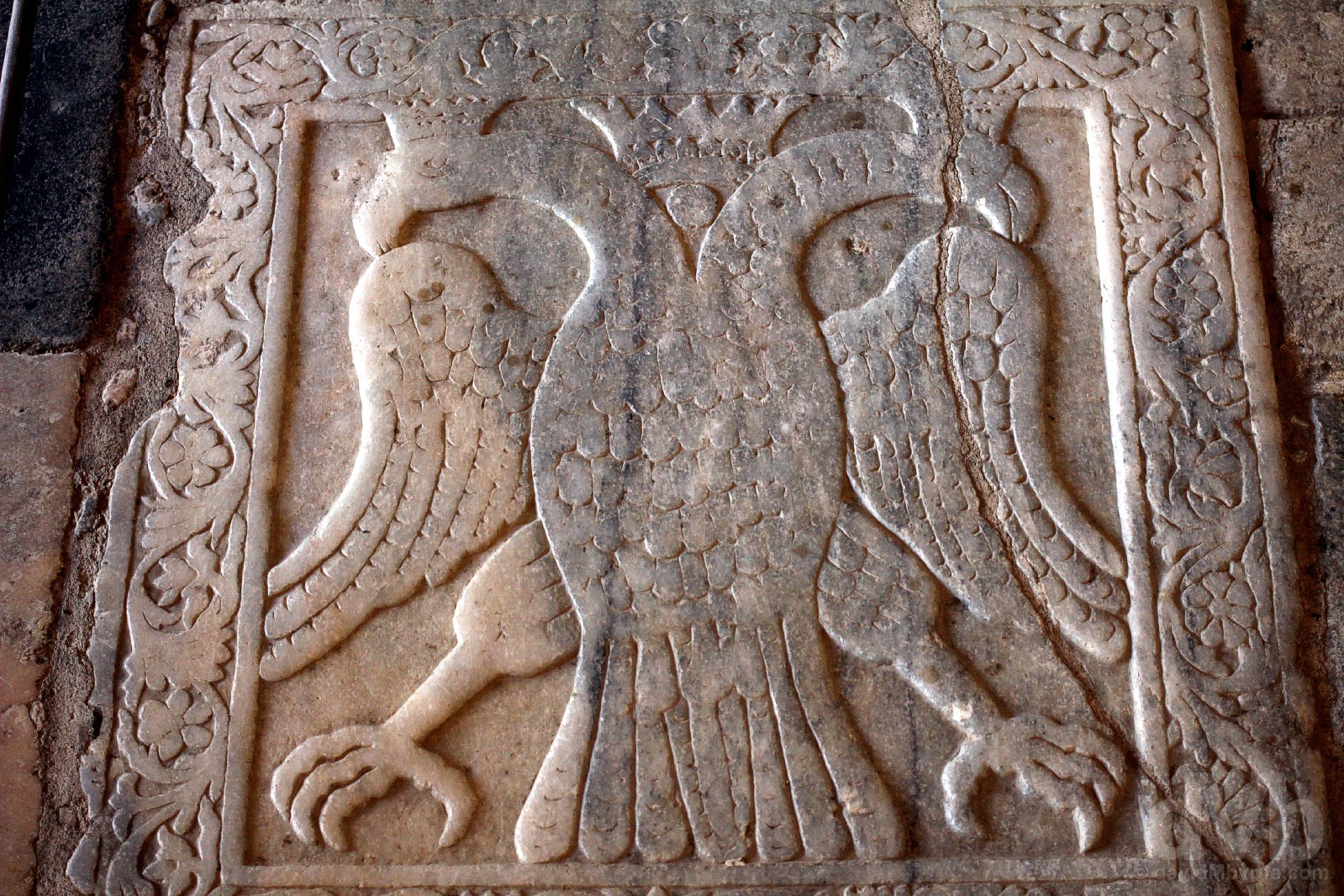
BYZANTIUM TWO-HEADED EAGLE | A marble two-headed eagle, the symbol of Byzantium, in relief set in the floor of the 13th century Church of Saint Demetrios, Mystras, Peloponnese, Greece. May 8, 2017.
The two-headed eagle was adopted as the imperial emblem under Constantine XI Palaiologos (1405-1453) and has since become the main symbol of Byzantium; it is speculated that it serves to represent the union of, or claims to, lands in two continents. The last Byzantine emperor, Palaiologos commanded Mystras as despot between 1443 and 1449 before moving to Constantinople and ascending the throne; he was soon to perish, along with his empire, in the Turkish sacking of Constantinople in 1453. The marble two-headed eagle slab set in the floor of the Church of Saint Demetrios commemorates his coronation in 1448 – it is said he was crowned emperor in the church while standing on this very flagstone.
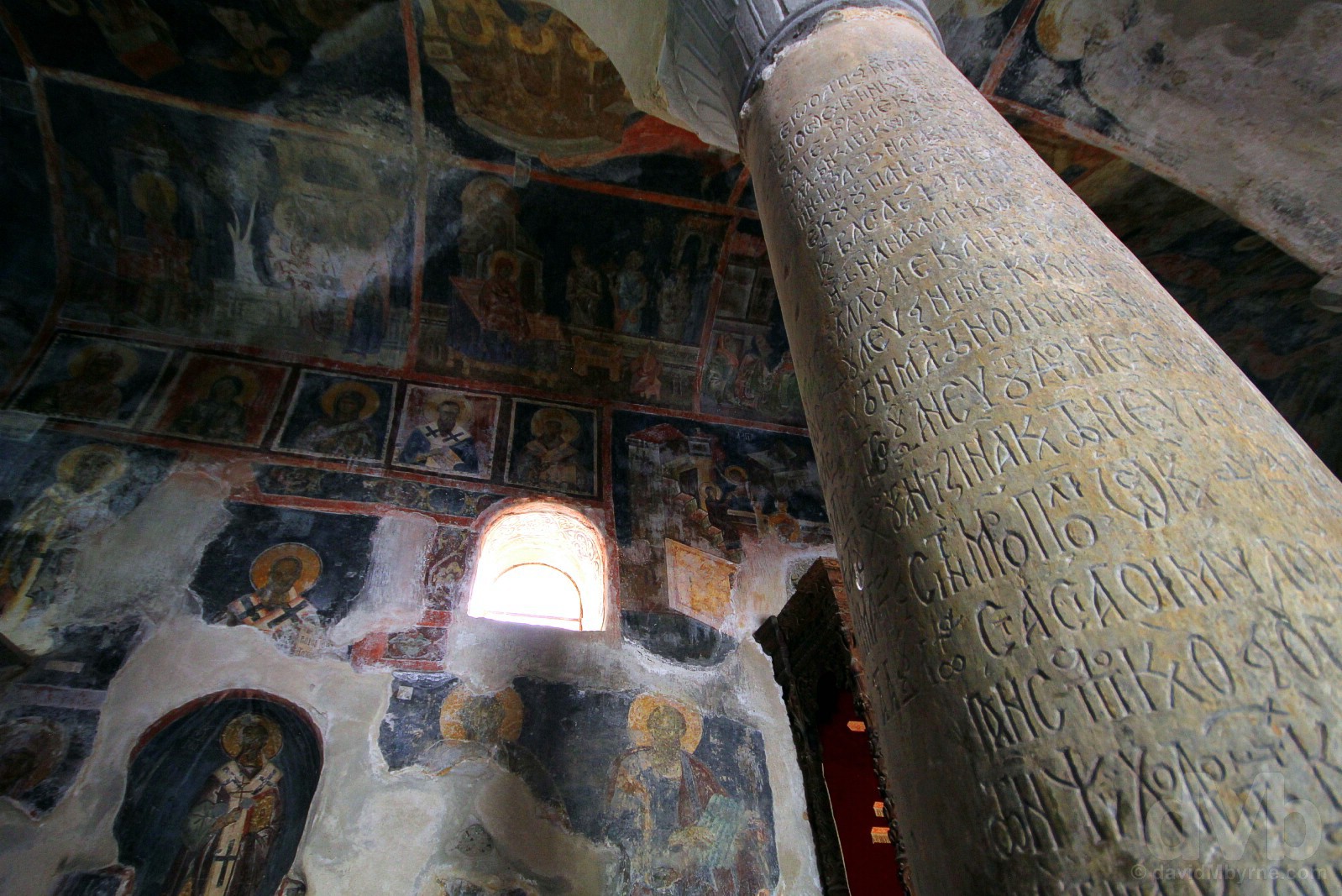
FRESCOS & CARVINGS |Frescos and carvings on a pillar of the 13th century Church of Saint Demetrios, Mystras, Peloponnese, Greece. May 8, 2017.
Like most of the churches in Mystras, the Church of Saint Demetrios is lavishly adorned with frescoes: the earliest depict the torture and burial of Áyios Dhimítrios, the saint to whom the church is dedicated. A series of frescoes also illustrate the miracles of Christ and the life of the Virgin; more intimate and lighter of touch, they date from the last great years before Mystras fell. Another highlight of the church is the carvings on its pillars, some of which, according to the information posted, is ‘text which was the “registry of ownership” of the Diocese’.

VIRGIN HODEGETRIA |The interior of the Church of the Virgin Hodegetria, Mystras, Peloponnese, Greece. May 8, 2017.
Founded c. 1309 and completed in c. 1322, the three-isle, five-domed Church of the Virgin Hodegetria, part of the site’s Brontochion Monastery, was the very first church to be built in the so-called Mystras architectural style. Lavishly adorned once again with frescos and with a somewhat unique style, decoration and choice of iconography, the various chapels of the church (all churches in Mystras have a small number of chapels within them, mostly in the four corners of the structure) also houses tombs of dignitaries of Mystras – some even have portrait and inscriptions in wall paintings above the tombs to identify the nobility resting here.

PALACE OF MYSTRAS |A portion of the Palace complex of Mystras, Peloponnese, Greece. May 8, 2017.
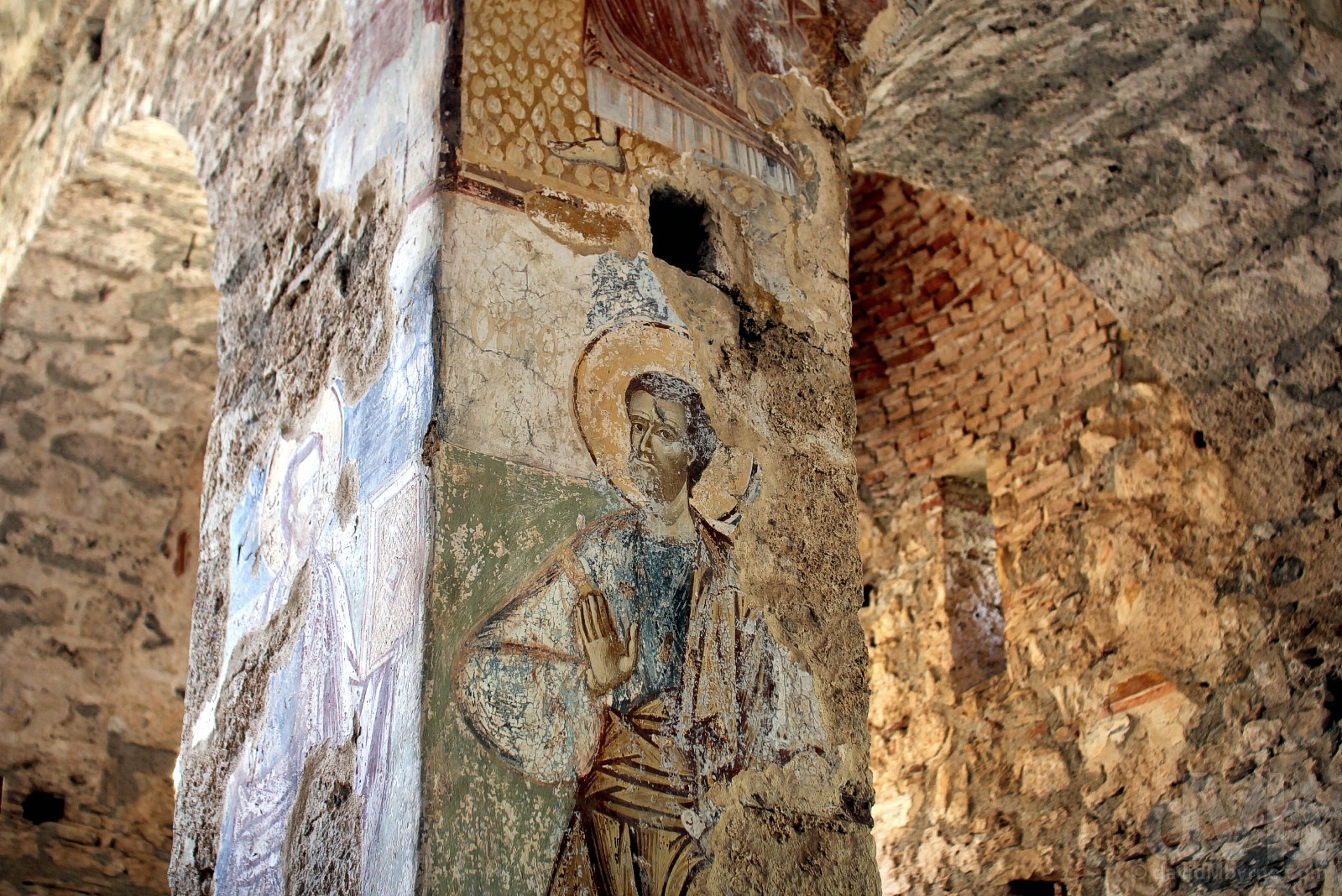
SAINT NIKOLAOS |Frescos in the Church of Saint Nikolaos, Mystras, Peloponnese, Greece. May 8, 2017.

MONASTERY REFECTORY |Among the UNESCO-listed ruins of Mystras, Peloponnese, Greece. May 8, 2017.
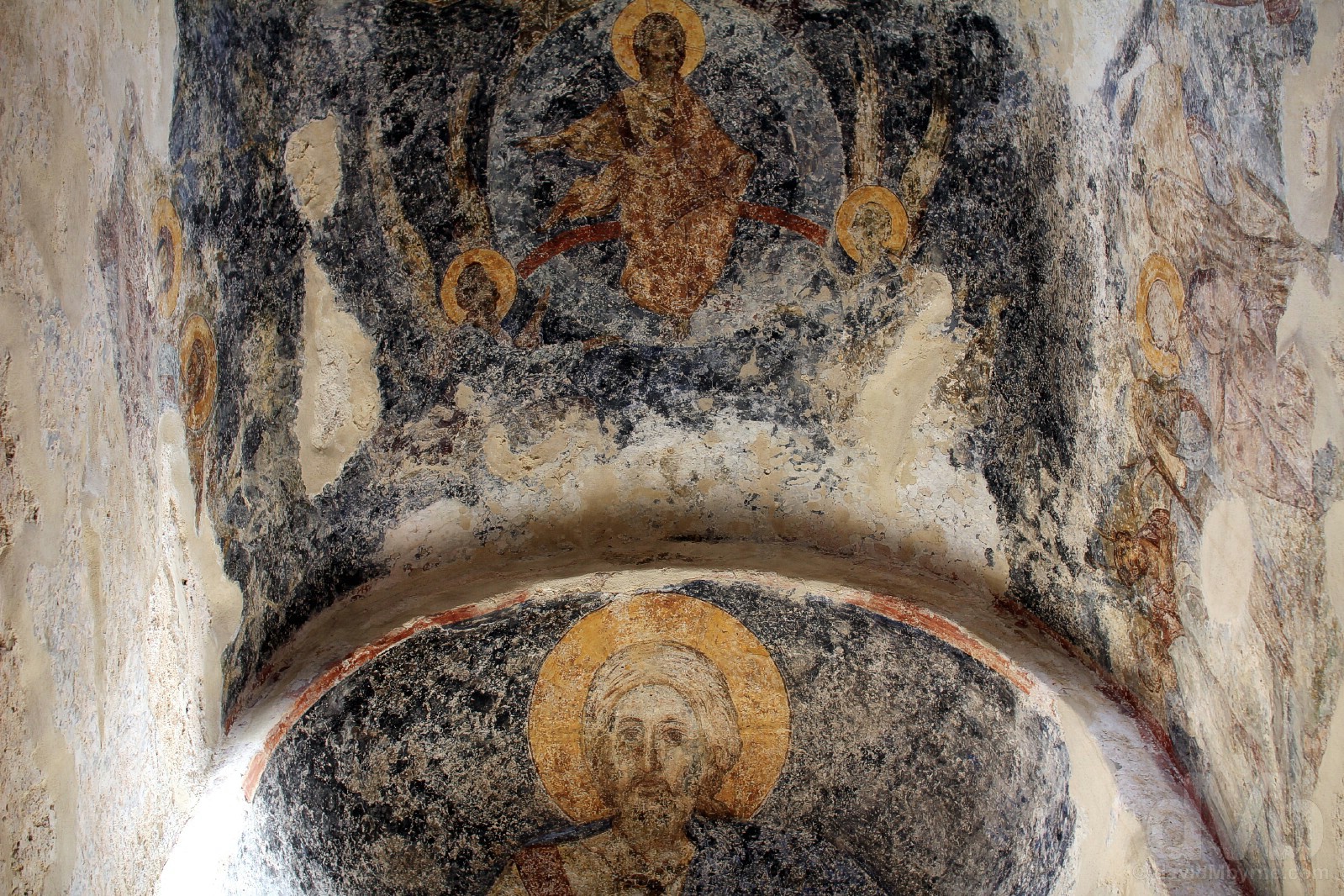
SAINT SOPHIA |Frescos in the Church of Saint Sophia, Mystras, Peloponnese, Greece. May 8, 2017.

CITADEL/CASTLE | Overlooking the Evrotas River Valley from the UNESCO-listed ruins of the Citadel/castle on the slopes of the Taygetus mountains in Mystras, Peloponnese, Greece. May 8, 2017.
Signing Off | The Complete Mystras Gallery

